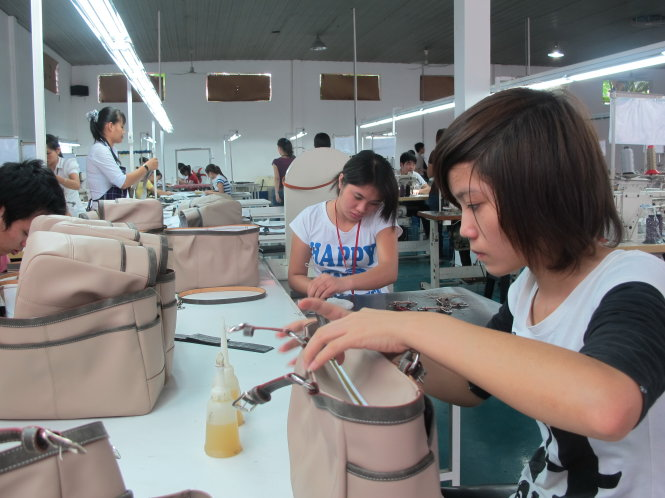Vietnam may emerge as a favorite spot for goods rerouting for Chinese manufacturers as they seek ways to circumvent import tariffs slapped by the U.S. amid its escalating trade war with China, local business leaders and analysts say.
The trade dispute between the world’s top economies officially broke out in June when the two nations' leaders in turn announced tariffs imposition on each other’s goods.
In the latest development of the trade tensions, U.S. President Donald Trump on Monday imposed ten percent tariffs on about US$200 billion worth of imports from China, and threatened duties on about $267 billion more if China retaliated. It took China only one day to respond with tariffs on about $60 billion worth of U.S. goods.
Under the pressure of higher tariffs, China-based firms are more likely to think of a workaround to beat the system.
According to Vietnamese experts, Chinese producers may redirect their raw materials exports toward Vietnam to hide the origin of their Chinese-made products to avoid U.S. tariffs.
This practice, known as goods rerouting, will affect the local industries in Vietnam.
Stricter control called for Chinese imports
With China now facing escalating retaliation from the U.S., Vietnam can take advantage of the opportunity to become an alternative supplier of textiles and garments for its northern neighbor.
But the country’s heavy reliance on imported raw materials from China makes Vietnam vulnerable to being taken advantage of by Chinese producers to reroute their goods there to avoid U.S. tariffs, according to Pham Xuan Hong, chairman of the Ho Chi Minh City Association of Garment-Textile-Embroidery-Knitting (AGTEK).
Vietnam’s textile and garment industry has to import 70 percent of its raw materials from overseas, and imports from China alone account for 50 percent.
In fact, a number of firms have already been importing intermediate goods into Vietnam, putting them through some minor process stages, and exporting them to the U.S., with the product origin by that point stated as Vietnam.
“This is an act of breaking the rules of origin,” Phan Thi Thanh Xuan, general secretary of the Vietnam Leather, Footwear and Handbag Association (LEFASO), said.
Xuan said it is essential that the Vietnamese government soon have a measure to stop this practice, otherwise Vietnam will suffer the consequence.
“If there is a sudden surge of exports from Vietnam, the U.S. will apply a more rigorous testing process to the shipments, and may end up adding the Southeast Asian country to its trade control list,” she elaborated.
Xuan also noted that most of the Chinese goods exported to the U.S. via Vietnam have a very low local content rate, meaning Vietnamese input materials and components only make up a modest proportion of the finished goods.
The LEFASO general secretary thus called on the government to stipulate that goods must has a minimum local content rate of 40 percent to be considered being of Vietnam origin, so as to mitigate the risk of cheating.
Sharing this view, Hong from AGTEK suggested that the government “strictly control imported goods and at the same time trace the origin of products shipped to the U.S.”
“Any violation of the rules of origin, if found, should be seriously punished,” he said.
“Otherwise, the whole industry will suffer.”
Don’t inadvertently abet cheaters
Vietnam’s textile and garment businesses are still studying to see which specific categories or items of the industry will suffer a direct impact from China’s rerouting practice, so as to have adequate solutions, according to Hong.
A case in point is the handbag category, whose risk of facing illegal origin transformation is especially high, according to LEFASO deputy chairman Diep Thanh Kiet.
A handbag is deemed domestically produced only when its raw materials are cut, sewn into the finished product and packaged in Vietnam, Kiet said.
“Even when Vietnamese businesses import already cut leather from China and complete the last two production stages in Vietnam, the final product is not considered ‘made in Vietnam’,” he underlined.
The problem is that many Vietnamese enterprises still get confused about this regulation, and thus may inadvertently assist the goods rerouting of Chinese producers, Kiet added.
According to the LEFASO deputy chairman, it is easy for Chinese raw materials, or even finished products, to enter Vietnam and be exported to other countries as ‘made-in-Vietnam’ products, thanks to the active cross-border trade between the two countries in the northern region.
But aside from this workaround, Kiet added, Chinese manufacturers still have another tactic to avoid U.S. tariffs - to relocate their factories to Vietnam.
“It’s not difficult for a company to move its factory in China to Vietnam as the manufacturing of handbags is quite simple, compared to other leather-based items,” he elaborated.
“A company only needs around $200,000 to complete hardware investment for a medium handbag factory.”
This workaround, if not thoroughly controlled, will have a heavy impact on Vietnam’s handbag industry, according to Kiet.
“If the U.S. government discovers this trend, they will immediately levy import duties on Vietnamese handbags, just like what they are doing with China,” Kiet expressed his concerns.
Like us on Facebook or follow us on Twitter to get the latest news about Vietnam!






















































